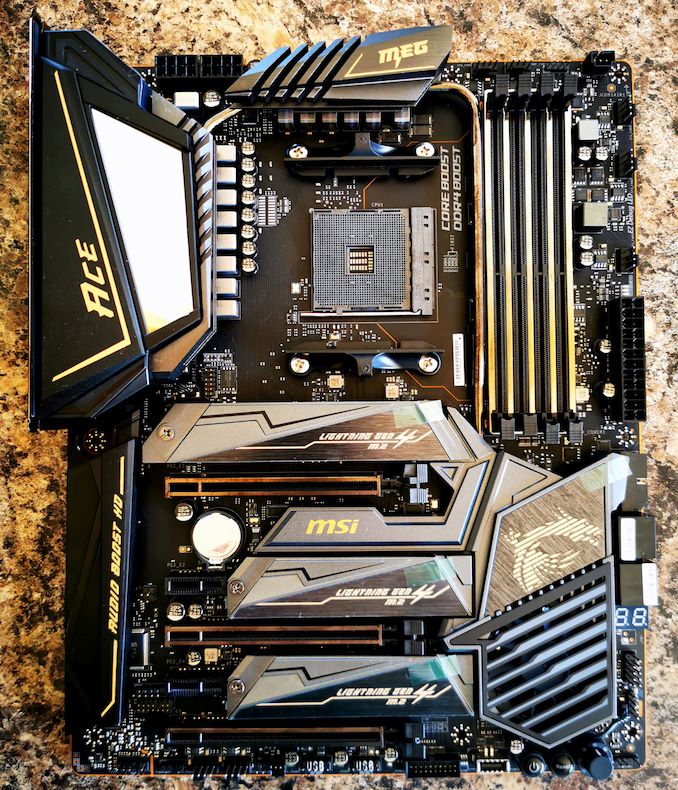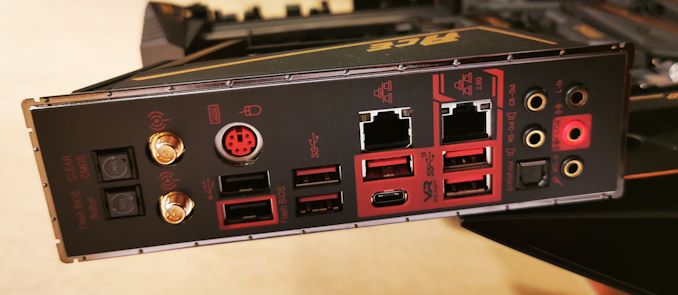The AMD X570 Motherboard Overview: Over 35+ Motherboards Analyzed
by Gavin Bonshor on July 9, 2019 8:00 AM ESTMSI MEG X570 Ace
Our full review of the MSI MEG X570 Ace is currently live with many more X570 models set to be fully reviewed and analyzed over the next couple of months.
The MSI MEG X570 Ace motherboard represents its premium MEG range and as we've seen from its range on the Intel Z390 chipset, MSI has followed the same naming structure for users to easily identify which each range signifies. The X570 Ace benefits from an Intel Wi-Fi 6 wireless interface, a Realtek 2.5 G NIC, three PCIe 4.0 x4 M.2 slots, and a 12+2 power delivery. Like all of MSI's X570 product stack with four memory slots, there is support for up to 128 GB of RAM.
The board has four DDR4 memory slots with support for up to DDR4-4600, three full-length PCIe 4.0 slots which operate at x16, x8/x8, and x8/x8/x4, with an additional two PCIe 4.0 x1 slots. Built into the X570 chipset heatsink is a cooling fan which uses MSI's Zero Frozr design as the X570 chipset has a rated TDP of up to 15 W. Providing power to the CPU is two 8-pin 12 V ATX power inputs, while the power delivery is using an extended 8 to 6.5 mm heat pipe which extends from the power delivery directly down to the chipset. The MEG X570 Ace has three PCIe 4.0 x4 M.2 slots, each with its own individual Lightning Gen4 M.2 heatshield which amalgamates into the boards black and gold designed heatsinks. Like the MSI MEG X570 Godlike, MSI's RGB Infinity Mirror 2 is present on the rear panel cover to allow users to customize the look of the board.
On the rear panel of the MSI MEG X570 Ace motherboard, there's a clear CMOS, and BIOS flashing button which has its own dedicated USB 3.1 G1 Type-A slot highlighted with a red outline. There are three USB 3.1 G2 Type-A ports, a single USB 3.1 G2 Type-C, two USB 3.1 G1 Type-A ports, and two USB 2.0 ports. Networking capability consists of a Realtek RTL8125AG 2.5 GbE NIC with the other Ethernet port being controlled by an Intel I211-AT Gigabit NIC. This model also includes integrated Wi-Fi with an Intel AX200 Wi-Fi 6 802.11ax wireless interface which also offers users with Bluetooth 5 connectivity. The five 3.5 mm audio jacks and S/PDIF optical output are driven by a Realtek ALC1220 HD audio codec.
The MSI MEG X570 Ace in terms of price and feature set is quite impressive and with an MSRP of $369 which makes it a highly competitive when compared with other models in its price range. The need for MSI to upgrade its networking capabilities on desktop motherboards is something they have started to implement, and the rear panel on the X570 Ace is also without video outputs so users looking to use Ryzen based APUs will need to look elsewhere.












225 Comments
View All Comments
PeachNCream - Tuesday, July 9, 2019 - link
Pretty much this. Modern games on DX12 won't see any benefit unless the game developer bakes in support (which they appear uninterested in doing for cost reasons) and older games run very well on a single modern GPU. AMD and NV are hardly acknowledging SLI these days either and nowhere but at the top end so there is even less compulsion for developers to bother with supporting it. All in all, you're better off not worrying about SLI unless the industry changes direction significantly in the next few years.ajlueke - Tuesday, July 9, 2019 - link
The real question however, is does all this power delivery actually have any practical benefits? If I drop a 3000 series CPU in an X570 board vs X470, can I achieve any additional performance? And what is the power consumption differences in the respective chipsets? That is the type of info I would like to see.PeachNCream - Tuesday, July 9, 2019 - link
It's a marketng differentiator only as motherboard manufacturers all use the same core components and are quick to emulate one another with similar features. Through branding and obscure features that do not significantly impact computer operation, they search for something they can offer that may encourage you to make a purchase in a very, very crowded field of offerings.lopri - Tuesday, July 9, 2019 - link
Solid power delivery for high-performance CPUs is perhaps the farthest thing from obscure marketing features. OEMs do play with marketing BS for differentiation, but the underlying power delivery system is extremely important and can impact everyday operation for these multi-core CPUs.PeachNCream - Wednesday, July 10, 2019 - link
At long as it meets AMD specifications, no it won't. If it doesn't meet specifications, then it's a bad design. There's no reason to tout being mediocre or a hair or two above mediocre unless you're running out of unique bullet points for the backside of the box that nobody bothers to read anyway.Death666Angel - Tuesday, July 9, 2019 - link
Stock performance will be the same across the board unless the manufacturer royally screwed up and the power delivery has to throttle due to temperatures (which there are some cases of with super cheap motherboards and 8 cores). Doing OC (and PBO is already OC) is where things start to change. More / better phases means less heat output and better voltages (ripple). This can potentially give you better clocks. But most of this is only useful when you start OCing on water or sub zero systems. Air cooled overclocking will hardly benefit at all. And regarding power consumption you can go into a lot of detail. Sometimes more power phases simply destroys efficiency, when they are all fired up all the time. Sometimes more power phases are smartly managed and load balanced to be kept at their optimal efficiency. It really depends on the implementation.Peter2k - Wednesday, July 10, 2019 - link
If you leave everything at stock, then there is no real reason to upgradeMost people would think keeping the socket backwards compatible as an upside
In a desktop the only real reason why we think about power draw going up from 5w to 11w is because manufactures like to keep the cooling block small, and those need a fan
Chipset fans bring back memories out of terrible noisy days
Also I remember chipset coolers to be a bit bigger in the past, I'm sure if you're just trying to provide food cooling, without trying to hit that gamer look, then you can cool that chipset without active fan
If you want to try your hand at OC'ing you should probably want the better power delivery
And there is no telling if the older boards will also run fine with higher memory speeds
Guessing they would, at least until the magical 3600, that's not that outlandish high
And how much that affects performance this time around still has to be tested
Short story
You have a Ryzen already, just make it a drop in replacement
No need to throw out the board
Peter2k - Wednesday, July 10, 2019 - link
Any one that would argue about the electricity costs going up (I've encountered those) should also not that all that shiny bling probably draws more watts then the 6w or so difference between last gen and this genpavag - Tuesday, July 9, 2019 - link
I expected benchmarks.sorten - Tuesday, July 9, 2019 - link
You expected benchmarks on 35+ boards that were released two days ago, and many of which aren't even available at retail?